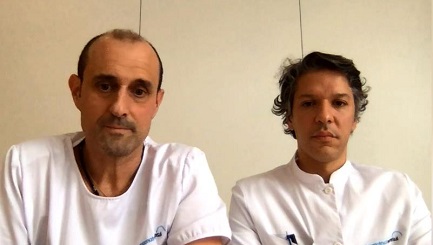The use of free chimeric flaps in head and neck reconstruction: technical pearls and clinical applications
Abstract
Aim: Head and neck region reconstructions are often delicate procedures that require different solutions at different layers. The use of chimeric flaps offers the interesting characteristic of combining different tissues, which is extremely valuable in this setting. In the present work, we share our experience with different types of conventional flaps, such as the radial flap, the medial sural artery perforator flap, and the fibula osteocutaneous flap.
Methods: Over the last year, a series of five patients received advanced head and neck defects reconstruction employing chimeric flaps. The patients included two females and three males, with the mean age of 68-year-old. The defect was in four cases due to radical tumor resection in the oromandibular region. The fifth case was an osteoradionecrosis which needed a complete resection of the affected soft and bony tissue.
Results: All five patients were successfully treated. Two of them received a chimeric free flap composed of multiple skin islands while the other three also comprised bone tissue transfer for mandible reconstruction. The mean follow-up period was ten months (range 3-8 months), and during this period neither postoperative complications nor signs of disease relapse were noted.
Conclusion: The results obtained resorting to the chimeric fashion of various free flaps suggests that they are an excellent solution from both the functional and aesthetic point of view. Specific technical modifications are proposed according to the case requirements.
Keywords
Introduction
Head and neck tissue defects may result as a consequence of severe traumas or, more frequently, after ablative oncologic procedures. The increasing age of the population and the widely diffused smoking habits are causing a remarkable number of these cases throughout the world[1].
Because of the delicate and complex structures of this anatomical region, the reconstructive procedures are often difficult and require accurate preoperative planning. It is, first of all, necessary to restore the original anatomy as closely as possible, trying to preserve the functionality of the affected structures, especially in the case of damages to the upper aerodigestive tract. Moreover, compared to other areas, the aesthetic result is not negligible here. To obtain a proper and long-standing three-dimensional reconstruction, different types of tissues with high pliability and stability over time might be required. The advent of the microsurgical free flap techniques has led to consistent improvements in this setting[2]. However, large orofacial defects usually cannot be reconstructed resorting to a single flap because of inadequate tissue components, dimensions, or volume. Multiple free flaps are not always feasible, in particular when the recipient site is severely depleted and few vessels are available[3].
For this reason, the chimeric flaps represent a precious tool. They consist of multiple spatially independent flaps, each with its own vascular supply, joined to a common vessel[4]. Alternative solutions are single free flap combined with a locoregional flap or multiple free flaps. Compared to them, chimeric flaps offer significant advantages in terms of versatility, maintaining a similar complications rate[5]. Resorting to this pattern allows combining more skin paddles and different tissues according to the need while still using a single vascular supply. Nowadays, in the armamentarium of plastic surgeons, there are different types of flaps that can be harvested in a chimeric fashion.
In the present work, we share our experience with chimeric flaps focused on advanced head and neck cancer reconstructions. According to need, we describe different solutions which imply the use of chimeric flaps including different skin paddles in combination with bones and muscles.
Methods
Over the last year, five chimeric flaps have been employed to reconstruct advanced defects in the head and neck setting. The patients included two females and three males, with the mean age of 67.2 years (range 52-78 years). The cause of the defect was related in four cases to radical oncologic resection of tumors affecting the oromandibular region. One case was performed following resection of osteoradionecrotic bone. Three different types of free flaps were used: one radial free forearm flap (RFFF), one medial sural artery perforator (MSAP) flap, and three free fibula flaps (FFF). The first two involved different skin paddles as chimeric forms, while the latter also comprised bone transfer [Table 1]. Normal vascular anatomy and arterial competence were ensured by preoperative evaluation of the lower extremities.
Patient demographics and case characteristics
| Case | Gender | Age | Diagnosis | Therapy | TNM-classification (UICC 2017) | Type of flap | Anastomosis | Follow up (months) | Complications |
|---|---|---|---|---|---|---|---|---|---|
| 1 | Woman | 78 | SCC alveolar ridge of the right mandible with infiltration of the bone and pathological fracture | Tumor resection including segmental
mandibulectomy, Homolateral neck dissection, Bridging osteosynthesis | pT4a pN3b(2/20) L0 V0 Pn1 | RFFF | Sup. thyroid artery
External jugular vein | 3 | none |
| 2 | Man | 66 | ORN of the left mandible, 20 years after surgical treatment of an oropharyngeal carcinoma (1998) followed by radiotherapy | Resection of the necrotic mandible segment,
Bridging osteosynthesis, Intra- and extraoral skin paddle to cover the soft tissue defect | pT4 pN2b M0 (1998) | MSAP | Sup. thyroid artery
Internal jugular vein | 16 | none |
| 3 | Woman | 52 | SCC of the left lateral floor of the mouth with infiltration of the mandible | Tracheotomy,
Tumor resection including segmental mandibulectomy, Primary reconstruction with bone and skin paddle | pT4 pN0(0/24) L0 V0 Pn1 | FFF | Sup. thyroid artery
Internal jugular vein (2x) | 9 | none |
| 4 | Man | 77 | SCC of the anterior floor of the mouth, infiltration of the mandible and of the extra-oral mental skin | Tracheotomy,
Bilateral neck dissection (I-III), Tumor resection from intra- to extraoral including segmental mandibulectomy Primary reconstruction with bone and skin paddle | pT4a pN1(1/71) L0 V0 Pn1 | FFF (intraoral) +
PMT (extraoral) | Sup. thyroid artery
Internal jugular vein (2x) | 4 | none |
| 5 | Man | 63 | SCC of the left mandible | Tracheotomy,
Bilateral neck dissection (I-III), Resection of the tumor, segmental mandibulectomy, Primary reconstruction with bone and skin paddle | pT4 pN3b(8/31) L0 V1 | FFF | Sup. thyroid artery
Internal jugular vein | 18 | none |
Results
All patients were successfully treated without perioperative or postoperative complications. Neither partial nor total flap failure was reported, and the bone transfer for mandible reconstruction was well integrated. The mean follow-up period was 10 months (range 3-18 months). During this period, no signs of disease recurrence were noted. Good aesthetic and functional results were obtained, and no secondary procedures were required.
Case 1
A 78-year-old woman with a diagnosis of squamous cell carcinoma (SCC) was treated by means of a segmental mandibulectomy. The ablative surgery left a defect in the right side of the mandible and involved the right part of the base of the tongue. The mandible was reconstructed with a bridging titanium plate which required additional soft tissue to be safely covered. Because of this demand, we planned a chimeric free RFFF with two skin paddles [Figure 1]. One was used to fill the oral defect and to reconstruct the base of the tongue, while the other covered the metallic plate on the mandible [Figure 2]. Only one long pedicle was used, which was anastomosed to the superior thyroideal artery and the external jugular vein.
Figure 1. Preoperative skin markings of the radial free forearm flap (top left); intraoperative picture the flap harvest in chimeric fashion (bottom left); and the split RFFF with two perforators supplying each skin paddle (right).
Figure 2. Intraoperative picture of the mandible reconstruction with titanium reconstruction plate (left); insetting of the RFFF using one paddle to fill the dead space over the mandible (top middle) and the other to reconstruct the base of the tongue (bottom middle); and postoperative three-dimensional situation at three months follow up (right). RFFF: radial free forearm flap.
A good functional and aesthetic result was obtained, and no signs of disease recurrence were noted during the three months of follow up.
Case 2
A 66-year-old male patient presented with osteoradionecrosis of the left side of the mandible complicated by a pathological fracture, 20 years after resection of a hypopharyngeal tumor followed by radiotherapy. Radical excision of the left side of the mandible and the posterior floor of the mouth was required. For the reconstruction, a chimeric free MSAP flap was planned. The dimension of the two skin paddles was tailored to suit the different defects. Three perforators were isolated from the pedicle: two supplied the larger island and one the smaller one. The latter was then partially de-epithelized to fill the oral defect, while the first covered the mandibular plate and reconstructed the upper part of the left neck [Figure 3]. The pedicle vessels were anastomosed to the transverse cervical artery and vein. No perioperative and postoperative complications were reported. The functional and aesthetic result was very satisfying [Figure 4].
Figure 3. Preoperative skin marking of the chimeric MSAP flap (top left); intraoperative picture of the elevation procedure with the isolation of two perforators (top right); and final chimeric flap elevation and harvest (bottom left, bottom right). MSAP: medial sural artery perforator.
Figure 4. Intraoperative picture of the mandible reconstruction with bridging titanium plate, and preparation of transverse cervical vessels for the anastomosis (top left); insetting of the flap to reconstruct the upper left neck (top right) and the floor of the mouth (top left); and final appearance at nine months follow-up (bottom right).
Case 3
A 52-year-old woman presented with a SCC of the left side of the mandible that required a segmental mandibulectomy and the resection of part of the floor of the mouth. To reconstruct this advanced composite defect, a chimeric FFF comprising bone and two skin paddles was planned [Figure 5] and a three-dimensional stereolithographic model using computer-aided design/computer-aided manufacturing (CAD/CAM) technology was produced. The model was used as a guide to precontour a reconstruction plate that was sterilized and used intraoperatively to facilitate flap shaping. The fibular bone was attached to the inner side of the plate to reconstruct the lower border of the missing mandible, while the epithelized soft tissue parts were used to fill the defect in the molar region and reconstruct the missing side of the tongue. During the harvest, we were able to obtain a long pedicle, which was then anastomosed to the superior thyroid artery and the internal jugular vein.
Figure 5. Preoperative skin marking of the chimeric FFF (top left); flap harvest with two perforator-based skin paddles (top right, middle left, middle right); intraoperative picture after segmental mandibulectomy (bottom left); and the excised specimen (bottom right). FFF: free fibula flap.
Because of the complex pathway of the vascular pedicle due to the insetting, intraoperative ICG imaging was performed to check the blood supply and the venous drainage after the anastomosis [Figure 6]. The postoperative course was uneventful, and the computed tomography performed at six months confirmed a complete integration of the bone transfer [Figure 7].
Figure 6. Intraoperative picture of the final insetting after mandible reconstruction, where two skin paddles were used to fill the dead space and reconstruct the base of the left part of the tongue (top left, top right); appearance of the vascular supply (bottom left); and ICG proof proper arterial flow and venous drainage (bottom right).
Case 4
A 77-year-old male patient with diagnosis of SCC of the anterior floor of the mouth infiltrating the mandible and the skin of the chin required a complete surgical excision of the mandible and the soft tissues from intra- to extra-oral [Figure 8]. To reconstruct this extended bone and soft tissue defect, a chimeric FFF was planned combining a long bony part with to skin paddles supplied by different perforators. Using a 3D stereolithographic model (CAD/CAM technology), a reconstruction plate was prebent and used for adapting the free fibula bone graft, which was modeled with two osteotomies in order to mimic the mandible anatomy [Figure 9]. The soft tissue islands were then used to reconstruct the oral defect. Because of the large volume missing on the chin, a second free tissue transfer was required to obtain a good and stable result. For this purpose, we chose a posteromedial thigh (PMT) flap [Figure 10]. The postoperative course was uneventful, a satisfactory functional and aesthetic result was obtained, and no signs of disease recurrence were noted. At four months follow-up, a computer tomography exam was performed, which confirmed a good integration of the fibular bone [Figure 11].
Figure 8. Intraoperative picture of the prebent titanium plate in situ and chin defect (left, middle); and the excised specimen (right).
Figure 9. Preoperative skin marking of the chimeric FFF (top left); flap harvest with two perforator-based skin paddles (above right); and multiple osteotomies of the fibula bone to match the reconstructive need (bottom left, bottom right). FFF: free fibula flap.
Figure 10. The PMT flap harvested for chin reconstruction (left); intraoperative picture of the final insetting (middle, right). PMT: posteromedial thigh.
Case 5
A 63-year-old male presented with a large SCC of the left retromolar trigone with a significant involvement of the mandibular bone and bilateral cervical lymph node metastasis. Because of safety resection margin requirements, we were forced to perform an hemimandibulectomy near the intraoral soft tissue resection. To reconstruct the big defect, we used a chimeric osteocutaneous FFF comprising a bone ready-osteotomized and a skin paddle [Figure 12]. Computer-aided design and manufacturing was used to create a three-dimensional stereolithographic model, which was used to prebend a titan reconstruction plate for fixation and contour of the neomandible. The skin island was used to fill the retromolar soft tissue defect, and the vascular pedicle was then anastomosed to the superior thyroid artery and internal jugular vein. No major or minor microvascular complication occurred, and a computed tomography performed at 17 months confirmed a complete integration of the reconstructed bone [Figure 13].
Figure 12. Preoperative skin marking of the chimeric FFF (left); intraoperative picture during flap elevation (top right); and the harvested flap with the skin paddle based on two perforators (bottom right). FFF: free fibula flap.
Discussion
Every time a complex three-dimensional tissue defect has to be reconstructed, different tissues might be required to respect the “like with like” principle. Furthermore, in the head and neck setting, it is also important to consider with special attention the functional preservation and aesthetic result. Microvascular free tissue transfer is now considered the gold standard for large defects reconstructions throughout the body, and this region is no exception[6,7].
The chimeric concept for free tissue transfers in the head and neck setting was initially proposed by Koshima et al.[8] to reconstruct large defects resorting to a single donor site. This allowed reducing both donor and recipient site morbidity and offered an extremely versatile solution for complex cases.
Other compound flaps previously described are composite and conjoined flaps. All these techniques allow harvesting different types of tissues from a single donor site, but, depending on the chosen type, the versatility for insetting is significantly different. Composite flaps consist of the transfer of multiple tissues components altogether, while the conjoined ones include flaps that are supplied by different vessels, but whose tissues are physically interconnected. The chimeric flaps, instead, are multiple independent flaps in which all the pedicles join into a single mother vessel[4]. This aspect is particularly interesting when facing a severely depleted neck, because of either large surgical excision or neoadjuvant radiotherapy.
The latissimus dorsi (LD) flap and the anterolateral thigh (ALT) flap represent the two most famous chimeric flaps in the head and neck reconstructive field. Because of its anatomical proximity, the LD flap can often be harvested as either a pedicled or a free flap and offers a large and pliable muscular part[9]. Its anatomy is constant and reliable, with a long pedicle[10]. The free chimeric form can include not only the LD muscle with separate skin paddle but also components from the subscapular system. These include a vascularized bone transfer as rib grafts, the serratus muscle with the fascia, and the thoracodorsal nerve. However, the popularity of this flap has diminished due to the relevant donor site morbidity and the availability of other effective free flap options. The chimeric ALT flap, described for the first time by Hallock[11] in 1991, became even more used and widely described. This technique allows for a quicker harvesting and offers a significantly lower donor site morbidity. It was appreciated since the beginning because cutaneous, fasciocutaneous, musculocutaneous, or a flow-through form is possible, according to the patient’s need. Moreover, other chimeric forms might comprise multiple skin islands with muscle (vastus lateralis, rectus femoris, or tensor fascia lata), with vascularized femoral nerve or the fascia lata. All these features are therefore extremely relevant for the reconstruction of complex head and neck defects[12,13].
Here, we would like to share and describe our experience with other types flaps harvested in chimeric fashion and used for advanced head and neck cancer reconstructions. These are the RFFF, the MSAP flap, and FFF.
Described for the first time by Soutar et al.[14] in 1983, the RFFF has since then been widely used for oral and tongue defects reconstructions because it provides a very thin and pliable skin paddle[15]. The pedicle is long and the anatomy is constant, making it one of the easiest flaps to harvest[16], but major drawbacks regard the donor site morbidity and the aesthetic result. One major artery is inevitably sacrificed, and the tendons will be exposed, requiring a skin graft coverage[17]. Even if not common, for this flap chimeric solutions are also possible. It can be harvested including vascularized nerve, tendon (palmaris longus, brachioradialis, and flexor carpi radialis), bone, incorporating a segment of the distal radius, and muscle, with a small piece of pronator quadratus. In our case, we were able to split the skin paddle into two parts, obtaining the perfect solution to reconstruct the base of the tongue and cover the metallic mandible plate using only one vascular pedicle.
The free MSAP was introduced in 2001[18] and might represent an evolution of the RFFF. Similar to the ALT, this is one of the modern perforator-based flaps which allows drastically decreasing donor site morbidity. Its thickness and volume can be tailored according to the need, and the sural nerve can be harvested to obtain a sensate flap[19]. The chimeric option might be composed of multiple skin paddles combined with part of the medial gastrocnemius muscle, making it a precious tool in complex reconstructions. In our case, we used one skin paddle to reconstruct the floor of the mouth and the other to fill the dead space in the upper neck.
In the late 1980s, the use of the FFF to reconstruct mandibular defects was described, and, over the following years, and many authors have contributed to optimize the technique. Today, this option is the gold standard for mandibular reconstruction, including in our center. In particular, in extended bone and soft tissue resections, this flap can be modeled with multiple osteotomies and can provide bone, muscle, and skin for composite reconstruction[20].
It provides a large and long vascular pedicle, a long-length well vascularized donor bone, and a pliable overlying skin. The bony strength allows good screw fixation for solid reconstructions or tooth implantation, and it can be shaped with multiple osteotomies in order to reach an excellent functional and aesthetic result[21]. The skin island is often adequate for head and neck reconstructions and usually guarantees very little soft tissue bulk. However, in the case of larger defects, this technique has been proposed in combination with other flaps such as RFFF[22], ALT flap[23], and free rectus abdominis flap[24].
We proposed three forms of chimeric FFF, two for mandible and floor of the mouth reconstruction and one, in combination with a free PMT flap, for mandible and chin reconstruction. In all cases, the versatility related to the independence of the single tissue components allowed a perfect insetting with a good functional and aesthetic result. The chin defect described in Case 4 was so large that the soft tissue chimeric part of the FFF was not sufficient to obtain a satisfactory volume restoration and a sufficient protection in the case of postoperative radiotherapy because the transferred skin appeared too thin. For this reason, an additional flap was required. However, this does not affect the critical role of the chimeric fashion of the primary flap. One of the two skin islands was the ideal solution for the reconstruction of the floor of the mouth, providing a small and pliable tissue. In such complex cases, it is often difficult to perfectly estimate the ideal shape and volumes required. For this reason, we tend to consider as a primary option the most versatile one, such as in this case the chimeric FFF, but we usually plan a thicker and safer supporting flap.
From the technical point of view, it is worth mentioning the preoperative process for vessels identification and flap harvest planning. We routinely perform a computed tomography angiography in order to have a clear visualization of the patient vascular anatomy. Then, we follow these data to mark the perforator pattern immediately before surgery, usually resorting to a simple hand-held doppler device.
Despite the limited number of cases, we believe that this series represents an interesting collection of non-conventional chimeric forms of otherwise well-known free flaps that may be particularly useful for the reconstruction of advanced head and neck defects.
In conclusion treatment of head and neck tumors is a cornerstone of oral and maxillofacial surgery. However, after extensive tumor resection or other substantial bone loss of the mandible due to osteoradionecrosis, optimal reconstruction of bone and soft tissues with sufficient aesthetic and functional outcome is a demanding challenge for both maxillofacial and plastic surgeons. In this context, the chimeric flaps represent the ideal reconstructive solution, offering two major advantages that can be summarized as follows: (1) a very high versatility with the combination of multiple and different tissues; and (2) the possibility of using only one recipient vascular supply.
Declarations
Authors’ contributionsPerformed all surgeries and revised the manuscript: Scaglioni MF, Tomasetti PE, Kuttenberger J, Fritsche E
Wrote the manuscript: Tomasetti PE, Meroni M
Availability of data and materialsData from Tomasetti Patrick, Department of Maxillo-facial Surgery Lucerne.
Financial support and sponsorshipNone.
Conflicts of interestAll authors declared that there are no conflicts of interest.
Ethical approval and consent to participateThis study was performed according to the regulations of the local ethics committee in conformity with the Declaration of Helsinki.
Consent for publicationThe presented individual details and images were obtained with the patient’s consent for publication.
Copyright© The Authors 2021.
REFERENCES
1. Thompson-Harvey A, Yetukuri M, Hansen AR, et al. Rising incidence of late-stage head and neck cancer in the United States. Cancer 2020;126:1090-101.
2. Haughey BH, Wilson E, Kluwe L, et al. Free flap reconstruction of the head and neck: analysis of 241 cases. Otolaryngol Head Neck Surg 2001;125:10-7.
3. Yazar S, Wei FC, Chen HC, et al. Selection of recipient vessels in double free-flap reconstruction of composite head and neck defects. Plast Reconstr Surg 2005;115:1553-61.
4. Hallock GG. Further clarification of the nomenclature for compound flaps. Plast Reconstr Surg 2006;117:151e-60e.
5. Ettyreddy AR, Chen CL, Zenga J, Simon LE, Pipkorn P. Complications and outcomes of chimeric free flaps: a systematic review. Otolaryngol Head Neck Surg 2019;161:568-75.
6. Haughey BH, Wilson E, Kluwe L, et al. Free flap reconstruction of the head and neck: analysis of 241 cases. Otolaryngol Head Neck Surg 2001;125:10-7.
7. Hurvitz KA, Kobayashi M, Evans GRD. Current options in head and neck reconstruction. Plast Reconstr Surg 2006;118:122e-33e.
8. Koshima I, Yamamoto H, Hosoda M, Moriguchi T, Orita Y, Nagayama H. Free combined composite flaps using the lateral circumflex femoral system for repair of massive defects of the head and neck regions: an introduction to the chimeric flap principle. Plast Reconstr Surg 1993;92:411-20.
9. Barton FE Jr, Spicer TE, Byrd HS. Head and neck reconstruction with the latissimus dorsi myocutaneous flap: anatomic observations and report of 60 cases. Plast Reconstr Surg 1983;71:199-204.
10. Bartlett SP, May JW Jr, Yaremchuk MJ. The latissimus dorsi muscle: a fresh cadaver study of the primary neurovascular pedicle. Plast Reconstr Surg 1981;67:631-6.
11. Hallock GG. Simultaneous transposition of anterior thigh muscle and fascia flaps: an introduction to the chimera flap principle. Ann Plast Surg 1991;27:126-31.
12. Song Y, Chen G, Song Y. The free thigh flap: a new free flap concept based on the septocutaneous artery. Br J Plast Surg 1984;37:149-59.
13. Park CW, Miles BA. The expanding role of the anterolateral thigh free flap in head and neck reconstruction. Curr Opin Otolaryngol Head Neck Surg 2011;19:263-8.
14. Soutar D, Scheker L, Tanner N, Mcgregor IA. The radial forearm flap: a versatile method for intra-oral reconstruction. Br J Plast Surg 1983;36:1-8.
15. Soutar DS, McGregor IA. The radial forearm flap in intraoral reconstruction: the experience of 60 consecutive cases. Plast Reconstr Surg 1986;78:1-8.
16. Yang G, Chen P, Gao Y, et al. Classic reprint Forearm free skin flap transplantation: a report of 56 cases. 1981. Br J Plast Surg 1997;50:162-5.
17. Richardson D, Fisher SE, Vaughan ED, Brown JS. Radial forearm flap donor-site complications and morbidity: a prospective study. Plast Reconstr Surg 1997;99:109-15.
18. Cavadas PC, Sanz-Giménez-Rico JR, Gutierrez-de la Cámara A, Navarro-Monzonís A, Soler-Nomdedeu S, Martínez-Soriano F. The medial sural artery perforator free flap. Plast Reconstr Surg 2001;108:1609-15. discussion 1616-7
19. Kim HH, Jeong JH, Seul JH, Cho BC. New design and identification of the medial sural perforator flap: an anatomical study and its clinical applications. Plast Reconstr Surg 2006;117:1609-18.
20. Weitz J, Wolff KD, Kesting MR, Nobis CP. Development of a novel resection and cutting guide for mandibular reconstruction using free fibula flap. J Craniomaxillofac Surg 2018;46:1975-8.
21. Levis C, Hynes N, Archibald S. Through and through defects of the lower face. Clin Plast Surg 2005;32:327-37. v-vi
22. Serletti JM, Coniglio JU, Tavin E, Bakamjian VY. Simultaneous transfer of free fibula and radial forearm flaps for complex oromandibular reconstruction. J Reconstr Microsurg 1998;14:297-303.
23. Wei FC, Celik N, Chen HC, Cheng MH, Huang WC. Combined anterolateral thigh flap and vascularized fibula osteoseptocutaneous flap in reconstruction of extensive composite mandibular defects. Plast Reconstr Surg 2002;109:45-52.
Cite This Article
How to Cite
Tomasetti PE, Kuttenberger J, Meroni M, Fritsche E, Scaglioni MF. The use of free chimeric flaps in head and neck reconstruction: technical pearls and clinical applications. Plast Aesthet Res. 2021;8:12. http://dx.doi.org/10.20517/2347-9264.2020.212
Download Citation
Export Citation File:
Type of Import
Tips on Downloading Citation
Citation Manager File Format
Type of Import
Direct Import: When the Direct Import option is selected (the default state), a dialogue box will give you the option to Save or Open the downloaded citation data. Choosing Open will either launch your citation manager or give you a choice of applications with which to use the metadata. The Save option saves the file locally for later use.
Indirect Import: When the Indirect Import option is selected, the metadata is displayed and may be copied and pasted as needed.



































Comments
Comments must be written in English. Spam, offensive content, impersonation, and private information will not be permitted. If any comment is reported and identified as inappropriate content by OAE staff, the comment will be removed without notice. If you have any queries or need any help, please contact us at support@oaepublish.com.